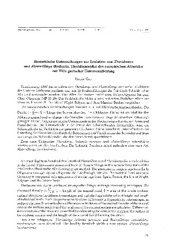Biometrische Untersuchungen zur Evolution von Theridomys und Blainvillimys (Rodentia, Theridomorpha) des europäischen Alttertiärs mit Hilfe grafischer Datenverarbeitung
Gad, Jürgen
21: 71 - 144
Gad, Jürgen, 1992: Biometrische Untersuchungen zur Evolution von Theridomys und Blainvillimys (Rodentia, Theridomorpha) des europäischen Alttertiärs mit Hilfe grafischer Datenverarbeitung. In: Mainzer geowissenschaftliche Mitteilungen, Band 21: 71 - 144, DOI: https://doi.org/10.23689/fidgeo-5705.
 |
Dokument öffnen: |
1800 Backenzähne von Theridomys und Blainvillimys von sechs Lokalitäten
der Unteren Süßwassermolasse und aus 21 Spaltenfüllungen der Fränkisch-Schwäbischen
Alb sind untersucht worden. Das Alter der Faunen reicht vom Unter-Oligozän bis zum
Ober-Oligozän (MP 20-25). Das Süddeutsche Material wird mit Arten ähnlichen Alters aus
Spanien, Frankreich, der Isle of Wight, Belgien und dem Mainzer Becken verglichen.
Die taxonomischen Untersuchungen basieren u. a. auf Bildverarbeitungsmethoden. Die
L2
Dichte (= L = Länge des Schmelzbandes, F = Okklusionsfläche) ist ein Maß für den
Abkauungsgrad und wird gegen das Verhältnis von Höhe zu Länge der einzelnen Zähne aufgetragen.
Diese Diagramme zeigen Unterschiede in der Hochkronigkeit zwischen Arten und
Populationen. Um Unterschiede in der Dicke des Schmelzbandes festzustellen, wird die
Schmelzfläche im Verhältnis zur gesamten Okklusionsfläche berechnet. Unterschiede in der
Eintiefung des Sinus werden durch die Berechnung des Verhältnisses der Schmelzbandlänge
zur Länge des Schmelzbandes, die den Sinus formt, quantifiziert.
Zwei neue Unterarten Theridomys ludensis suevicus und Blainvillimys rotundidens
moehrenensis werden beschrieben. Die Lokalität Bernloch liefert außerdem eine neue Art,
Blainvillimys bernlochensis. Abstract: Eighteen hundred cheek teeth of Blainvillimys and Theridomys from six localities
in the Lower Süßwassermolasse and from 21 fissure fillings in the Jurassic limestone of the
Fränkisch-Schwäbische Alb (Germany) are studied.The associations ränge in age from Early
Oligocene through Upper Oligocene (MP 20 through MP 25). The material from Southern
Germany is compared with specimens of similar age from Spain, France, the Isle of Wight,
Belgium and the Mainz basin.
The taxonomic studies are based among ofher things on image processing techniques.The
L2
structural density (= ppp?; L = length of the enamel band, F = area of the whole occlusal
surface) describes the different wearstages and is plotted againstthe ratio of heightand length
of individual teeth. Such diagrams serve to show differences in hypsodonty between species
and populations. In order to show differences in thickness of the enamel the ratio of the enamel
area on the occlusal surface and the total area of the occlusal surface are calculated. Differences
in indentation of the sinus are quantified by calculating the ratio of the length of the outline of
the occlusal surface and the length of the enamel band forming the sinus.
Two new subspecies, Theridomys ludensis suevicus and Blainvillimys rotundidens
moehrenensis were described. The locality Bernloch yields a new species, Blainvillimys
bernlochensis.
1. Einleitung
2. Material und Methoden
3. Systematik
3.1. Genus Theridomys Jourdan 1837
3.1.1. Theridomys aquatilis Aymard 1949, in Gervais
3.1.2. Theridomys sp.
3.1.3. Theridomys brachydens Gad 1987
3.1.4. Theridomys ludensis Vianey-Liaud 1985
3.1.4.1. Theridomys ludensis ludensis Vianey-Liaud 1985
3.1.4.2. Theridomys ludensis suevicus n. ssp.
3.1.5. Theridomys lembronicus Bravard, in Gervais, 1848
3.2. Genus Blainvillimys
3.2.1. Blainvillimys rotundidens (Schlosser 1884)
3.2.1.1. Blainvillimys rotundidens rotundidens (Schlosser 1884)
3.2.1.2. Blainvillimys rotundidens moehrenensis n. ssp.
3.2.2. Blainvillimys bernlochensis n. sp.
3.2.3. Blainvillimys heimersheimensis Bahlo 1975
3.2.4 Blainvillimys blainvillei (Gervais 1848)

